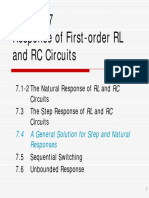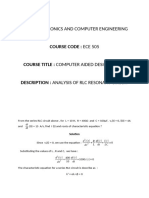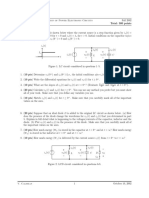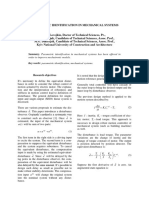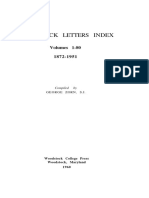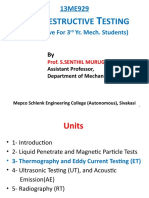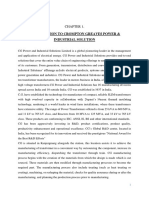Capacitive Flux Compression Generator
Capacitive Flux Compression Generator
Uploaded by
ΑΝΔΡΕΑΣ ΤΣΑΓΚΟΣCopyright:
Available Formats
Capacitive Flux Compression Generator
Capacitive Flux Compression Generator
Uploaded by
ΑΝΔΡΕΑΣ ΤΣΑΓΚΟΣOriginal Title
Copyright
Available Formats
Share this document
Did you find this document useful?
Is this content inappropriate?
Copyright:
Available Formats
Capacitive Flux Compression Generator
Capacitive Flux Compression Generator
Uploaded by
ΑΝΔΡΕΑΣ ΤΣΑΓΚΟΣCopyright:
Available Formats
CAPACITIVE FLUX COMPRESSION GENERATOR
A. Cheldavi
Department of Electrical Engineering, Iran University of Science and Technology
Narmak,16844, Tehran, Iran, Fax +98-21-7454055 , Tel +98-21-7808022, cheldavi@iust.ac.ir
M. M. Danaei
Imam Hossein University
Tehran, Iran
(Received: July 2, 2002 - Accepted in Revised Form: May 15, 2003)
Abstract Conventional Flux Compression Generators (FCG's) are used to generate high power DC
pulses. A new kind of (FCG's) with series capacitance called Capacitive Flux Compression Generator
(CFCG) will be introduced and explained in this paper. This new kind is used to generate modulated
high power pulses. There are some problems to establish a capacitance in high power and high
frequency applications. In the present paper several practical methods will be addresed to make
capacitance in high power and high frequency applications.
Key Words Flux Compression Generator, High Power Sources, High Frequency Sources
ﺳﺎﺧﺘﻪ ﺷﺪﻩ ﻭ ﻣﻮﺭﺩ ﺍﺳﺘﻔﺎﺩﻩ ﻗﺮﺍﺭDC ﭼﮑﻴﺪﻩ ﻣﻮﻟﺪ ﻫﺎﻱ ﺷﺎﺭ ﻓﺸﺮﺩﻩ ﻣﻌﻤﻮﻟﻲ ﺑﺮﺍﻱ ﺗﻮﻟﻴﺪ ﭘﺎﻟﺴﻬﺎﻱ ﺗﻮﺍﻥ ﺯﻳﺎﺩ
ﻧﻮﻉ ﺟﺪﻳﺪﻱ ﺍﺯ ﺍﻳﻦ ﻣﻮﻟﺪﻫﺎ ﺗﺤﺖ ﻋﻨﻮﺍﻥ ﻣﻮﻟﺪ ﺷﺎﺭ ﻓﺸﺮﺩﻩ ﺧﺎﺯﻧﻲ ﺩﺭ ﺍﻳﻦ ﻣﻘﺎﻟﻪ ﻣﻌﺮﻓﻲ ﻣﻲ ﺷﻮﺩ ﻛﻪ.ﻣﻲ ﮔﻴﺮﻧﺪ
ﺑﺮﺍﻱ ﺍﻳﻦ ﻛﺎﺭ ﺍﺯ ﻳﻚ.ﺗﻮﺍﻧﺎﻳﻲ ﺍﻳﺠﺎﺩ ﭘﺎﻟﺲ ﻫﺎﻱ ﺗﻮﺍﻥ ﺯﻳﺎﺩ ﺩﺭ ﻓﺮﻛﺎﻧﺲ ﺩﻣﺎﻱ ﺑﺎﻻ )ﺩﺭ ﺣﺪ ﭼﻨﺪ ﺩﻩ ﻣﮕﺎ ﻫﺮﺗﺰ( ﺭﺍ ﺩﺍﺭﺩ
ﺑﺮﺍﻱ ﺍﻳﺠﺎﺩ ﺍﻳﻦ ﺧﺎﺯﻥ ﺳﺮﻱ ﺑﺎﻳﺪ ﺍﺯ. ﻣﻮﺭﺩ ﺍﺳﺘﻔﺎﺩﻩ ﻗﺮﺍﺭ ﻣﻲ ﮔﻴﺮﺩ،ﺧﺎﺯﻥ ﺳﺮﻱ ﻛﻪ ﺑﺎ ﺳﻠﻒ ﻣﻮﻟﺪ ﺭﺯﻧﺎﻧﺲ ﻣﻲ ﻛﻨﺪ
.ﺭﻭﺷﻬﺎﻱ ﺧﺎﺻﻲ ﺍﺳﺘﻔﺎﺩﻩ ﻛﺮﺩ ﻛﻪ ﺧﺎﺻﻴﺖ ﺧﺎﺯﻧﻲ ﺩﺭ ﺟﺮﻳﺎﻥ ﻭ ﻓﺮﻛﺎﻧﺲ ﻫﺎﻱ ﺑﺎﻻ ﺣﻔﻆ ﺷﻮﺩ
1. INTRODUCTION briefly in [15]. Some possible mechanisms of
losses have been developed in [16]-[17]. S. I.
FCG's are used extensively in several applications Shkuratov [18] focused on the development of
especially when high current pulses are needed in generators using kinetic energy of ferromagnetic
applications such as electromagnetic launchers, projectiles. [19]-[21], explained several concepts
welding metal forming, geological mapping, and for production of initial energy to power magnetic
radar. FCG's can be considered as linear electrical FCG's, and finally [22]-[24] present some special
generators. Electromagnetic energy is stored in an noval FCG's. Capacitive flux compression generator
inductor with an initial "seed current". Mechanical (CFCG) is a devise to generate high frequency
motion causes a decrease in the system inductance modulated high power pulses. Its function is the
at such a rapid rate that the flux interlinked with it subject of a limited number of researches [25-26].
has no time to diffuse out and, therefore remains Fundamentals of high explosives, CFCG principles
practically constant. FCG's have been the subject with an emphasis on the helical generator, as well
of many studies [1-20]. The principal ideas on as limiting physical mechanisms will be addressed
FCG's and its applications following the interesting in this paper.
work of Kapitza [1] have been presented in [2]-
[12]. [13] Addressed some problems regarding
microsecond pulsed high power generators. [14] 2. ONE DIMENSIONAL MODELING
Introduce a FCG code with special interesting
capabilities. Figure 1 shows the circuit model for CFCG. It is
Proximity and skin effects have been explained supposed that R and C are constants and L(t) is a
IJE Transactions A: Basics Vol. 16, No. 4, December 2003 - 337
Differentiating 4 yields to
d 2 i di dL di i
L 2 + + (R − a ) + = 0 (5)
dt dt dt dt C
or
d 2i di i
L 2
+ (R − 2a ) + = 0 (6)
Figure 1. The circuit model for CFCG. dt dt C
The initial current and voltage stored in the
inductor and capacitor are i(0) = I0 and vc(0) = 0.
So one has
v c (0) + L(0)i ′(0) + Ri(0) + i(0)L′(0) = 0 (7)
or
(a − R ) I 0
i ′(0) = (8)
L0
Defining
Figure 2. L(t) as a function of time.
t R − 2a 2−
R
variable as shown in Figure 2. The differential p( t ) = exp ∫ dτ = (L 0 − at ) a (9)
equation describing the system is given as 0 L 0 − aτ
d
[Li] + Ri + 1 ∫ idt = 0
R
(1) p( t ) 1−
dt C s( t ) = = (L 0 − at ) a (10)
L 0 − at
in which
6 can be written as
L 0 − L1
L = L0 − t = L 0 − at (2) d di s( t )
T p( t ) + i=0 (11)
dt dt C
From 1 one has
It can be shown that 11 is self adjoint. So it has a
di dL 1 unique solution as
L +i + Ri + ∫ idt = 0 (3)
dt dt C ∞
i( t ) = ∑ a n t r + n (12)
or n =0
di 1 where an and r are constants to be determined.
L + (R − a )i + ∫ idt = 0 (4)
dt C Setting 12 in 6 and choosing r = 0 gets to
338 - Vol. 16, No. 5, January 2003 IJE Transactions A: Basics
∞
L1
(L 0 − at )∑ a n n (n − 1) t n − 2 + 1−
n=2 a L0
So because = >> 1 , the coefficients
∞
1 ∞ L0 T
(R − 2a )∑ a n nt n −1 + ∑ antn = 0
n =1 C n =0 becomes larger and larger without limit. To
(13) overcome this problem the definition of the
coefficients in 12 must be changed as
Setting n-2=m in the first summation and n-1= m
∞
in the second summation yield to t
i( t ) = ∑ (a n T n )( ) n (19)
n+0 T
∞
∑L a
m =0
0 m+ 2 (m + 2)(m − 1) t m +
t
Choosing = τ and anTn = bn one gets to
1 T
(R − 2a )a m +1 (m + 1) t m + amtm −
C
∞
i(τ) = ∑ b n τ n
∞
a ∑ a m +1 m(m + 1) t = 0 m (20)
n+0
m =1
(14)
So
This gets to
di di dτ 1 di
= = (21)
1 dt dτ dt T dτ
2a 2 L 0 + (R − 2a )a 1 + a 0 = 0 (15)
C
Setting 21 in 6 yields to
Satisfying the boundary conditions requires that
L0 d 2i di T
( − at ) 2 + (R − 2a ) + i = 0 (22)
− RI 0 T dτ dτ C
a 0 = i(0) = I 0 ; a 1 = i ′(0) = (16)
L0
Now the coefficients are obtained as
Using a0 and a1, a2 can be obtained as
T2
b m+2 = − bm +
I 0 − 1 (R − 2a )R L 0 C(m + 2)(m + 1)
a2 = ( + ) (17)
L 0 2C 2L 0 aTm − (R − 2a )T
b m +1
L 0 (m + 2)
Using a recursive relation one gets to the final (23)
solution for the unknown coefficients as
As it is clear in the limit when m → ∞ one has
1
a m+2 =− am +
L 0 C(m + 2)(m + 1) aT L
(18) b m+2 = b m +1 = (1 − 1 )b m +1 (24)
am − (R − 2a ) L0 L0
a m +1
L 0 (m + 2)
L1
Because 1 − ≤ 1 , bm converges. Note that to
As it is clear from 18, in the limit as m → ∞ , am+2 L0
a obtain bm we need b0 = a0 and b1 = a1T. For t ≥ T
approaches to a m +1 .
L0 the current can be obtained solving the simple following
IJE Transactions A: Basics Vol. 16, No. 4, December 2003 - 339
Figure 3. Current for L1 = 0.5µF, L0 = 10mH, C=0.05nF and T=20µs and different R .
2a
differential equation T ∞ bn L ∞
i ′(T) = ∑ − 1
RC n =0 n + 1 R
∑b
n =0
n (27)
2
d i R di 1
2
+ + i=0 (25)
dt L1 dt L1C
3. ELECTRICAL GAIN
using the initial conditions as
∞
Electrical gain is the most important factor in FCG
i (T ) = ∑ b n (26) design procedure. This parameter is defined as the
n =0 ratio of the electrical energy (delivered to the load)
340 - Vol. 16, No. 5, January 2003 IJE Transactions A: Basics
Figure 4. Electrical gain for different
L0 .
L1
to the initial magnetic energy stored in the So the electrical gain is obtained as
inductor. The electrical energy delivered to the
∞ ∞
load can be written as bmbn
RT ∑ ∑
We n =0 m=0 n + m + 1
1 ∞ ∞
b b = (29)
We = ∫ R 2 i 2 (τ)dτ = R ∑ ∑ m n (28) Wm 1
L 0 I 02
0 n =0 m = 0 n + m + 1 2
IJE Transactions A: Basics Vol. 16, No. 4, December 2003 - 341
4. EXAMPLES AND RESULTS Conversion”, New York, McGraw-Hill, (1966).
9. Levi, E. and Zabar, Z., “Basic Design of Electrical
Consider a circuit as shown in Figure 1. It is Machines”, IEEE Trans. Power App. Syst., Vol. PAS-
104, (1985), 1513-1518.
supposed that the initial current in the circuit is 1 10. Levi, E., Zabar, Z. and Birenbaum, L., “Basic
Ampere. The current and capacitor voltage Performance of Flux-Compression/Expansion
R Electromechanical Converters”, IEEE Trans. Plasma
waveforms for different values of , L0 = 10mH, Sci., Vol. 20, No. 5, (Oct. 1992), 554-561.
a 11. Engle, T. G., Becker, J. E., Nunnally, W. C., “Energy
L1 = 0.5µH, C = 0.05nF, and T = 20µs are shown Conversion and High Power Pulse Production Using
in Figure 3. The electrical gain ratio is shown in Miniature Magnetic Flux Compressors”, IEEE Trans.
Plasma Sci., Vol. 28, No. 5, (Oct. 2000), 1342-1346.
R L 12. Novac, B. M. et al., “A Novel Flux Compression/Dynamic
Figure 4 for different values of and 0 . Transformer Technique for High-Voltage Pulse
a L1
Generation”, IEEE Trans. Plasma Sci., Vol. 28, No. 5,
(Oct. 2000), 1356-1361.
13. Turchi, P. J., “Problems and Prospects for Microsecond
Pulsed Power Above Ten Mega Ampers”, IEEE Trans.
Plasma Sci., Vol. 28, No. 5, (Oct. 2000), 1414-1421.
4. CONCLUSIONS 14. Cash, M. A. et al., “Benchmarking of a Flux Compression
Generator Code”, IEEE Trans. Plasma Sci., Vol. 28, No.
A simple one-dimensional approach is given for 5, (Oct. 2000), 1434-1439.
analysis and design of CFCG. The current gain and 15. Novac, B. M., Smith, I. R. and Enache, M. C., “Accurate
Modeling of the Proximity Effect in Helical Flux-
the electrical gain are obtained. This approach is
Compression Generators”, IEEE Trans. Plasma Sci., Vol.
based on the circuit principles, so it can be used for 28, No. 5, (Oct. 2000), 1353-1355.
the design of CFCG up to few hundred megahertz. 16. Neuber, A. A. et al., “Optical Diagnostics on Helical Flux
For higher frequency design and analysis two or Compression Generators”, IEEE Trans. Plasma Sci., Vol.
three-dimensional methods must be used which is 28, No. 5, (Oct. 2000), 1445-1450.
17. Shkuratov, S. I. et al., “Pulsed Power Generation Using
the subject of the future work of the authors. As it Open and Closed Ferromagnetic Circuits”, IEEE Trans.
is clear from the figures, this device can be Plasma Sci., Vol. 28, No. 5, (Oct. 2000), 1347-1352.
designed for electrical gain around 10000. 18. Altgilbers, L. et al., “Magnetocumulative Generators”,
New York, Springer-Verlag, (2000).
19. Fowler, C. M., Garn, W. B. and Caird, R. S., “Production
of Very High Magnetic Fields by Implosion”, J. Appl.
Phys., Vol. 31, No. 3, (1960), 588-594.
5. REFERENCES 20. Fowler, C. M., Caird, R. S. and Erickson, D. J., Eds.,
“Megagauss Technology and Pulsed Power Application”,
1. Kapitza, P. L., “Further Developments of the Method of New York, Plenum, (1987).
Obtaining Strong Magnetic Fields”, Proc. Roy. Soc., 21. Golovina, V. V. et al., “Magnet-Powered Initial Stage of
A115, (1927), 658. Magnetic Flux Compressor”, in Megagauss and
2. Lewin, J. D. and Smith, P. F., “Production of Very High Megaampere Pulse Technology and Applications, Russia,
Magnetic Field by Flux Compression”, Rev. Sci. Inst., Sarov VNIIEF, (1997), 333.
Vol. 35, (1964), 541. 22. Sheppard, M. G. et al., “MC-1 Generator Performance
3. Kuoepfel, H., “Pulsed High Magnetic Fields”, North with Higher-Energy Explosives", Tenth IEEE Pulsed
Holland, (1970). Power Conference, Albuquerque, NM, (July 1995).
4. Pande, H. C., “Linear Analysis of Electromechanical 23. Fowler, C. M. et al., “The Russian-American High
Pulser”, AIEE Trans. pt. I, Vol. 80, (1961), 309-315. Magnetic Field Collaboration”, Tenth IEEE Pulsed
5. Pande, H. C., “Current-Source Excitation Type Power Conference, Albuquerque, NM, (July 1995).
Electromechanical Pulser”, AIEE Trans. Communication 24. Fowler, C. M., “Four Decades in the Megagauss World”,
and Electronics, Vol. 74, (1964), 528-535. Physica B, 246, (1998), 158.
6. Pretap, S. B. et al., “A Compulsator Driven Rapid-Fire 25. Onochin, V. V., “Analysis of the Equivalent Circuit of
EM Gun”, IEEE Trans. Magn., Vol. 20, No. 2, (1984), Explosive Magnetic Generator of Frequency”, http://www.
211-214. laboratory.ru/articl/phys/eap050.htm.
7. Driga, M. D. et al., “Advanced Compulsator Designs”, 26. Soshenko, V. A. and Ivanov, V. C., “Investigation of the
IEEE Trans. Magn., Vol. 25, (1989), 142-146. Parameters of Explosive Driven Magnetic Generator of
8. Levi, E. and Panzer, M., “Electromechanical Power Frequency”, Proc. of EUROM Conf., (Aug. 1998).
342 - Vol. 16, No. 5, January 2003 IJE Transactions A: Basics
You might also like
- Lesson 3 - Personal Power Lab - AtharvaDocument3 pagesLesson 3 - Personal Power Lab - AtharvaAtharva Satpute60% (5)
- 1091 Circuit Theory HW1 Solution: Tera T Giga G (Femto FDocument5 pages1091 Circuit Theory HW1 Solution: Tera T Giga G (Femto F曾燒餅No ratings yet
- AQA Physics: 4 Waves Exam-Style QuestionsDocument8 pagesAQA Physics: 4 Waves Exam-Style QuestionsMoses AhmedNo ratings yet
- LCR CircuitDocument14 pagesLCR CircuitCOSM-OS50% (2)
- Thermal Equivalent Calcn of Short Circuit CurrentDocument12 pagesThermal Equivalent Calcn of Short Circuit CurrentAnonymous yD6Qpiq3No ratings yet
- Ch07 STDDocument41 pagesCh07 STDMohsan BilalNo ratings yet
- Progress in Electromagnetics Research C, Vol. 34, 41-52, 2013Document12 pagesProgress in Electromagnetics Research C, Vol. 34, 41-52, 2013Santiago CadenaNo ratings yet
- RLC RootsDocument4 pagesRLC Rootsgrey scottNo ratings yet
- V01 - Waves On Transmission LinesDocument16 pagesV01 - Waves On Transmission LinesNabil DakhliNo ratings yet
- circuits applicationsDocument4 pagescircuits applicationss12113028No ratings yet
- Sensors: A Voltage Mode Memristor Bridge Synaptic Circuit With Memristor EmulatorsDocument19 pagesSensors: A Voltage Mode Memristor Bridge Synaptic Circuit With Memristor EmulatorsMohamed ElashriNo ratings yet
- EQ CKT of DRA 2020Document21 pagesEQ CKT of DRA 2020asudhakar21520No ratings yet
- Sliding Mode Control Based On Fractional Order Calculus For DC-DC ConvertersDocument15 pagesSliding Mode Control Based On Fractional Order Calculus For DC-DC ConverterssathishNo ratings yet
- EE-211 Linear Circuit Analysis: Dr. Hadeed Ahmed SherDocument27 pagesEE-211 Linear Circuit Analysis: Dr. Hadeed Ahmed SherHadeedAhmedSherNo ratings yet
- (演習課) 考古題重新打字 - Ch1 ~ Ch5Document5 pages(演習課) 考古題重新打字 - Ch1 ~ Ch5frank941214No ratings yet
- Rolling Your Own Circuit Simulator - Jeff TrullDocument24 pagesRolling Your Own Circuit Simulator - Jeff Trullalan88wNo ratings yet
- Analysis of D Converter: K. K. Phanisri KruthiventiDocument6 pagesAnalysis of D Converter: K. K. Phanisri KruthiventiTJPRC PublicationsNo ratings yet
- A New Discretization Algorithm of Linear Canonical TransformDocument5 pagesA New Discretization Algorithm of Linear Canonical TransformActivities with Arnav GoelNo ratings yet
- Mathematical Models of Control SystemsDocument63 pagesMathematical Models of Control SystemshaithamNo ratings yet
- Chapter 4 Part 2 EditDocument26 pagesChapter 4 Part 2 EditR Loghanyah M.RameshNo ratings yet
- Lesson 8 Et 438 ADocument34 pagesLesson 8 Et 438 Amyself_riteshNo ratings yet
- Chapter 3Document15 pagesChapter 3Gemechis AsfawNo ratings yet
- Art I Go CN Mac 2024 Armando VelasquezDocument7 pagesArt I Go CN Mac 2024 Armando VelasquezMaria Luisa Velasquez VelasquezNo ratings yet
- Linear System Theory: Dr. Vali UddinDocument49 pagesLinear System Theory: Dr. Vali UddinMuhammad HassanNo ratings yet
- A Brief Review of Laplace TransformsDocument10 pagesA Brief Review of Laplace TransformsSupriya AnandNo ratings yet
- Midterm 1Document3 pagesMidterm 1tt_aljobory3911No ratings yet
- EE-211 Linear Circuit Analysis: Dr. Hadeed Ahmed SherDocument22 pagesEE-211 Linear Circuit Analysis: Dr. Hadeed Ahmed SherHadeedAhmedSherNo ratings yet
- Memristors 61 70Document10 pagesMemristors 61 70Tamas ZefferNo ratings yet
- ECE 353 Radio Comm Circuits PDFDocument66 pagesECE 353 Radio Comm Circuits PDFJos1No ratings yet
- State EquationsDocument35 pagesState EquationsParsa AseminiaNo ratings yet
- Modeling and Simulation: Qiu-Zhou Runall - Tex - 12/25/2008 3:19am Page 13Document51 pagesModeling and Simulation: Qiu-Zhou Runall - Tex - 12/25/2008 3:19am Page 13Samuel ChanNo ratings yet
- Special Topics in Power - 1Document38 pagesSpecial Topics in Power - 1Ravichandran SekarNo ratings yet
- Chapter 7 Response of First Order RL and RC CircuitsDocument29 pagesChapter 7 Response of First Order RL and RC CircuitsEng MazenNo ratings yet
- Industrial Control: Assignment IIDocument12 pagesIndustrial Control: Assignment IIOMAR ALEJANDRO LONGORIA VAZQUEZNo ratings yet
- Transmission Line Write UpDocument10 pagesTransmission Line Write UpAbhishek AgrawalNo ratings yet
- Lecture 3Document11 pagesLecture 3Syed Hussain Akbar MosviNo ratings yet
- ControlDocument55 pagesControlHuyThaiNo ratings yet
- Fractional Heat Conduction in A Semi-Infinite Composite BodyDocument13 pagesFractional Heat Conduction in A Semi-Infinite Composite BodysijyvinodNo ratings yet
- Lecture 2Document37 pagesLecture 2yab AbateNo ratings yet
- Circuit Simulation Using X CosDocument16 pagesCircuit Simulation Using X Cosmcardinot12No ratings yet
- Matlab and Simulink For Modeling and ControlDocument13 pagesMatlab and Simulink For Modeling and ControlnevesunipampaNo ratings yet
- Differential Equation ModelDocument13 pagesDifferential Equation ModelYash BhattNo ratings yet
- Chapter2 1Document38 pagesChapter2 1hassen miberNo ratings yet
- Free OscillationsDocument8 pagesFree OscillationsAnonymous 70j56EwNo ratings yet
- 4장 솔루션Document61 pages4장 솔루션hbinnn29No ratings yet
- ArticleDocument14 pagesArticlealipirkhedriNo ratings yet
- Alexander CH 08 Final R 1Document18 pagesAlexander CH 08 Final R 1kifle203No ratings yet
- Chapter 3 Part IDocument68 pagesChapter 3 Part IDaniel MengeshaNo ratings yet
- Alexander CH 08 Final R1Document18 pagesAlexander CH 08 Final R1utpNo ratings yet
- Energies 10 00799 v2Document14 pagesEnergies 10 00799 v2balasubramani krishnamurthiNo ratings yet
- N DSP6Document10 pagesN DSP6sadhanatiruNo ratings yet
- Lecture 2Document36 pagesLecture 2habtemariam woredeNo ratings yet
- Torque and Speed Control of Switched Reluctance Machine Using The Linearization Feedback TechniqueDocument9 pagesTorque and Speed Control of Switched Reluctance Machine Using The Linearization Feedback TechniqueHafid OubouaddiNo ratings yet
- Simulation TX Ham RadioDocument10 pagesSimulation TX Ham Radioyukie heningNo ratings yet
- Capacitor and ResistorDocument20 pagesCapacitor and ResistorMit MANo ratings yet
- Second Order CircuitDocument24 pagesSecond Order CircuitKJKSZPJ LXGIWYLNo ratings yet
- Control Systems Theory: Transfer Function of Physical Systems STB 35103Document108 pagesControl Systems Theory: Transfer Function of Physical Systems STB 35103Akula Veerraju100% (1)
- RectifiersDocument51 pagesRectifiersfa21-bee-015100% (1)
- Networks Ppt2 SharedDocument22 pagesNetworks Ppt2 SharedAviral UpadhyayNo ratings yet
- Parametric Identification in Mechanical SystemsDocument3 pagesParametric Identification in Mechanical Systemsbombardir.2001No ratings yet
- Powersys 3Document39 pagesPowersys 3setsindia3735No ratings yet
- The Spectral Theory of Toeplitz Operators. (AM-99), Volume 99From EverandThe Spectral Theory of Toeplitz Operators. (AM-99), Volume 99No ratings yet
- Green's Function Estimates for Lattice Schrödinger Operators and ApplicationsFrom EverandGreen's Function Estimates for Lattice Schrödinger Operators and ApplicationsNo ratings yet
- 144mhzWidebandNoiseAmplifier Text PDFDocument4 pages144mhzWidebandNoiseAmplifier Text PDFΑΝΔΡΕΑΣ ΤΣΑΓΚΟΣNo ratings yet
- 875 2016 06 10 PDFDocument126 pages875 2016 06 10 PDFΑΝΔΡΕΑΣ ΤΣΑΓΚΟΣNo ratings yet
- 144 MHZ Stop-Band TVI Filters PDFDocument1 page144 MHZ Stop-Band TVI Filters PDFΑΝΔΡΕΑΣ ΤΣΑΓΚΟΣNo ratings yet
- 432 Collinear From Coax PDFDocument4 pages432 Collinear From Coax PDFΑΝΔΡΕΑΣ ΤΣΑΓΚΟΣNo ratings yet
- Jallman@dts - Edu: The Lord'S Supper Be 542 A Syllabus I. Course DescriptionDocument5 pagesJallman@dts - Edu: The Lord'S Supper Be 542 A Syllabus I. Course DescriptionΑΝΔΡΕΑΣ ΤΣΑΓΚΟΣNo ratings yet
- 160Vs80 meterIsolatedOff Center Fedantennas PDFDocument11 pages160Vs80 meterIsolatedOff Center Fedantennas PDFΑΝΔΡΕΑΣ ΤΣΑΓΚΟΣ100% (1)
- 88 1 176 1 10 19570601 PDFDocument8 pages88 1 176 1 10 19570601 PDFΑΝΔΡΕΑΣ ΤΣΑΓΚΟΣNo ratings yet
- 80MeterVerticalTopHatForDx PDFDocument3 pages80MeterVerticalTopHatForDx PDFΑΝΔΡΕΑΣ ΤΣΑΓΚΟΣNo ratings yet
- 30W Linear On 23cm: Sage Wire Line, What IsDocument5 pages30W Linear On 23cm: Sage Wire Line, What IsΑΝΔΡΕΑΣ ΤΣΑΓΚΟΣNo ratings yet
- 50 Ohm Wideband Detectors PDFDocument15 pages50 Ohm Wideband Detectors PDFΑΝΔΡΕΑΣ ΤΣΑΓΚΟΣNo ratings yet
- 80-Meter Dipoles and Inverted-Vs A Graphical ScrapbookDocument36 pages80-Meter Dipoles and Inverted-Vs A Graphical ScrapbookΑΝΔΡΕΑΣ ΤΣΑΓΚΟΣNo ratings yet
- 44 29 p3 PDFDocument158 pages44 29 p3 PDFΑΝΔΡΕΑΣ ΤΣΑΓΚΟΣNo ratings yet
- 11-15 Panel-Bible in Its Near Eastern Co PDFDocument1 page11-15 Panel-Bible in Its Near Eastern Co PDFΑΝΔΡΕΑΣ ΤΣΑΓΚΟΣNo ratings yet
- Ower Er e 7762: 24 Em-Band Linear P Amplifi Modu M5Document5 pagesOwer Er e 7762: 24 Em-Band Linear P Amplifi Modu M5ΑΝΔΡΕΑΣ ΤΣΑΓΚΟΣ100% (1)
- 23cm PSK Packet Radio Transceiver For 1.2 Mbit/ User Access: ASE SKDocument23 pages23cm PSK Packet Radio Transceiver For 1.2 Mbit/ User Access: ASE SKΑΝΔΡΕΑΣ ΤΣΑΓΚΟΣNo ratings yet
- Loghz Atv The Ea Way: R AofnhDocument18 pagesLoghz Atv The Ea Way: R AofnhΑΝΔΡΕΑΣ ΤΣΑΓΚΟΣNo ratings yet
- 10 1 1 458 869 PDFDocument239 pages10 1 1 458 869 PDFΑΝΔΡΕΑΣ ΤΣΑΓΚΟΣNo ratings yet
- 12V To 24V - Converter PDFDocument2 pages12V To 24V - Converter PDFΑΝΔΡΕΑΣ ΤΣΑΓΚΟΣNo ratings yet
- 07 06 13 PDFDocument356 pages07 06 13 PDFΑΝΔΡΕΑΣ ΤΣΑΓΚΟΣNo ratings yet
- 10 1 1 667 5487 PDFDocument217 pages10 1 1 667 5487 PDFΑΝΔΡΕΑΣ ΤΣΑΓΚΟΣNo ratings yet
- 10 1 1 269 7271 PDFDocument325 pages10 1 1 269 7271 PDFΑΝΔΡΕΑΣ ΤΣΑΓΚΟΣNo ratings yet
- HZ Rac Tor Tun Unn Lla Tor: 10 G Va Edg OsciDocument4 pagesHZ Rac Tor Tun Unn Lla Tor: 10 G Va Edg OsciΑΝΔΡΕΑΣ ΤΣΑΓΚΟΣNo ratings yet
- 7 DB For 7 Bucks - Text PDFDocument2 pages7 DB For 7 Bucks - Text PDFΑΝΔΡΕΑΣ ΤΣΑΓΚΟΣNo ratings yet
- Lecture Notes On Classical Mechanics For Physics 106abDocument396 pagesLecture Notes On Classical Mechanics For Physics 106abPiyawat SuetrongNo ratings yet
- Experiment 204: Torque: Second Condition of Equilibrium: Result and DiscussionDocument5 pagesExperiment 204: Torque: Second Condition of Equilibrium: Result and DiscussionDave Vendivil SambranoNo ratings yet
- Power Voltage Transformers: A New Solution For Power Systems in The RegionDocument6 pagesPower Voltage Transformers: A New Solution For Power Systems in The RegionkashifNo ratings yet
- Phys Int CC CH 19 - Electrical Circuits - Answers PDFDocument6 pagesPhys Int CC CH 19 - Electrical Circuits - Answers PDFmayaNo ratings yet
- Magnetism and Electromagnetism School Lab Manual by Junior ScientistDocument12 pagesMagnetism and Electromagnetism School Lab Manual by Junior ScientistGopi Chand100% (1)
- Viva Qns Solutions 15Document3 pagesViva Qns Solutions 15assentialNo ratings yet
- Varistor Selection ProcedureDocument34 pagesVaristor Selection ProcedurePoornima SridaranNo ratings yet
- Physics Gravitation ProjectDocument21 pagesPhysics Gravitation ProjectAdityaNo ratings yet
- Lecture Note 4 Blood Flow MetersDocument45 pagesLecture Note 4 Blood Flow Metersulaga nathanNo ratings yet
- Standard Ac Eng PDFDocument324 pagesStandard Ac Eng PDFPranav KrishnaNo ratings yet
- Haefely-Hipotronics-1 Basic TDR Techniques WPDocument8 pagesHaefely-Hipotronics-1 Basic TDR Techniques WPbpchimeraNo ratings yet
- ON Estructive Esting: (Core Elective For 3 Yr. Mech. Students)Document58 pagesON Estructive Esting: (Core Elective For 3 Yr. Mech. Students)ganesh gowthamNo ratings yet
- Physics 1401 (Chapters 1-5) Review - Chapter 1,2Document33 pagesPhysics 1401 (Chapters 1-5) Review - Chapter 1,2FRANCISCO JERHYL KEITH G.No ratings yet
- EEE SUST Syllabus Session 2011-12Document31 pagesEEE SUST Syllabus Session 2011-12Shahadat Hussain ParvezNo ratings yet
- 2017-05-08 007 PBBSc-1 PDFDocument123 pages2017-05-08 007 PBBSc-1 PDFSwapna josephNo ratings yet
- Mini Project On Auto-Reclosing: Presented byDocument16 pagesMini Project On Auto-Reclosing: Presented byvaraprasad93No ratings yet
- Design and Implementation of Wireless Power Transmission Via Radio FrequencyDocument7 pagesDesign and Implementation of Wireless Power Transmission Via Radio FrequencyBilisuma ZewduNo ratings yet
- Measuring InstrumentsDocument2 pagesMeasuring InstrumentsAmethystwolfNo ratings yet
- Worksheet 25Document5 pagesWorksheet 25Dilini WijesinghNo ratings yet
- Fixtures PDFDocument20 pagesFixtures PDFAbhishek GorkarNo ratings yet
- Difference Between DTC and Scalar Mode PDFDocument6 pagesDifference Between DTC and Scalar Mode PDFVitali LursmanashviliNo ratings yet
- Bts426l1 SMD Infineon (Lu)Document15 pagesBts426l1 SMD Infineon (Lu)BRUNONo ratings yet
- Minimizing Penalty in Industrialpower Factor Correction by Engaging Apfc UnitDocument15 pagesMinimizing Penalty in Industrialpower Factor Correction by Engaging Apfc UnitabellNo ratings yet
- Safety Criteria For Evaluation of Railway Vehicle DerailmentDocument8 pagesSafety Criteria For Evaluation of Railway Vehicle Derailmentgenico_68No ratings yet
- Phyc-2121-Week-11-20 (NEW)Document89 pagesPhyc-2121-Week-11-20 (NEW)Albern BarbacNo ratings yet
- PSA-II Manual 2016schemeDocument58 pagesPSA-II Manual 2016schemeAashish RajNo ratings yet
- SPS Grade 7 Module Week 1Document23 pagesSPS Grade 7 Module Week 1Cris Vincent OlvidaNo ratings yet





